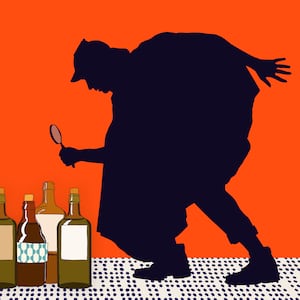Ever look at a bottle of Wild Turkey 101 and wonder why 101? Why not 102?
You’re asking about the so-called proof, the number that tells you how much of the whiskey is alcohol (ethanol, to be precise). Almost all of the rest is water, except for a tiny but extremely significant bit of flavor and aroma compounds that accumulate during mashing, fermentation, distillation and barrel aging.
In a small number of bottlings, those labeled cask-strength or barrel proof, the proof of the whiskey is exactly what comes out of the barrel. The distiller measures that with a government-approved instrument and puts the reading on the label. Whiskies of this type, like Booker’s Bourbon or Aberlour A’bunadh Single Malt Scotch, will vary in proof from batch to batch, but have the same general taste profile.
In other whiskies, the proof is set by adding carefully measured amounts of water to the spirit to dilute it to bottling strength. That bottling strength is determined by science, by flavor, by tradition and yes, sometimes the marketing department and sometimes the accountants. The science and sensory part of it are fascinating, and I’ve got a whole piece coming on that because learning about it was such an eye-opener.
But the traditional and the marketing influences are interesting, too. Chances are you’ve never really thought about why those numbers are what they are and it’s a good story.
American proof numbers are simply the percentage by volume of alcohol in a spirit, doubled. So a bottled-in-bond bourbon, at 100 proof, would be 50 percent alcohol by volume (ABV); an 80 proof Canadian whisky would be 40 percent ABV. We don’t usually talk about the “proof” of beers or wines; they’re almost always expressed directly in percent ABV.
The reason for that is that spirits used to be subject to much more scrutiny than beer or wine. The difference between a 45 percent ABV spirit and a 55 percent ABV one is not as quickly evident as a watered-down beer or wine. The market, and human nature being what it is, a rough-and-ready method was devised.
The story goes (and if you read my recent radler beer story, those words should definitely get your nonsense radar tingling) that the Royal Navy needed a way to “prove” that the rum (and occasionally brandy or arrack, depending on supply) served to sailors as part of their daily rations was full strength, not watered down. The rum ration was one of the few bright spots a sailor could count on in a low-paying job that was long on toil, discipline and monotony tempered with frequent lethal danger. Fiddling with the so-called daily tot to save money could bring a crew to mutiny, so any rumor of watered rum had to be nipped in the bud ASAP.
The navy did this, as needed, by showing the sailors that the rum, mixed with a pellet of gunpowder, would readily ignite and burn steadily. This was considered “proof” and rum that met the test was deemed “proof spirit.” And despite my “the story goes” misgivings, the gunpowder test is almost surely true, though it may have come from the UK’s taxation protocols rather than the Royal Navy. A quibble, and I’m not going to let the (possible) truth get in the way of a good story.
True or not, lighting liquor and gunpowder on fire is a limited and inconsistent measure, not even considering the safety aspects, so a more scientific one evolved as chemistry advanced. Again, it was the British, with their double obsession with booze and taxes, who came up with the tools and rules to get it done. In 1816, a “proof spirit” was determined to be liquor that weighed 12/13 as much as an equal volume of water (at 51° F), which made 100 proof in this system the equivalent of 57.06 percent alcohol by volume. Easy peasy.
I’m, of course, joking. It is ridiculously complicated, but the Brits stuck with it for more than 150 years, and while most of the common proof points are connected to the simpler American system, there are little bits of the British one sticking around today. Let’s go to the numbers to find them.
Today, you’ll see a lot of unique proofs on whiskey labels. My fellow whiskey writer Chuck Cowdery suspects that is often for marketing purposes, they’re being different for the sake of being different.
But I lean toward what Tim Heuisler, the Old Overholt Rye Whiskey brand ambassador told me when he was explaining the 92.6 proof number on last year’s one-off release of Old Overholt 11 year old. “We just sat around tasting different proofings until we loved it,” he said, “and I’d love to think every odd proof came from that same reason.” Me too, Tim.
But the majority of proofs tend to be one of the following numbers. Here’s my explanation (or best guess) as to why each exists:
80 proof/40 percent ABV has been the legal minimum in the major whiskey producing nations–the U.K., Ireland, Canada and the U.S.–for decades. But not everywhere: I have a bottle of Sam Cougar “bourbon,” produced for the Australian market by MGP, which is bottled at 78 proof. The taxes in Australia are incredibly high and the shipping costs are great, so this allows the brands to lower their prices a bit. There’s also the allowance of 40 proof “diluted whiskey” in Ohio (thanks again to Chuck Cowdery for telling me about that oddness).
86 proof/43 percent ABV was the legal minimum in the UK between 1879 and 1916, when it was lowered to 40 percent as part of wartime food rationing (and Prime Minister David Lloyd George’s teetotaler ambitions). But 86 proof had become a tradition, and you still see it on a number of whiskies, American and Scottish.
90 proof/45 percent ABV was a very common proof for American whiskey in the mid-20th century. Those of us who’ve been at this a long time remember that Jack Daniel’s Old No. 7 was 90 proof until 1987 when it was dropped to 86 and then it went to 80 in 2004. (Cynical drinkers suspected it had to do with increasing production and profits, since lowering the proof just meant adding more water to the whiskey.) It’s interesting to note that Jack Daniel’s got away with it, but Maker’s Mark had to take back their 2013 decision to lower their proof to 84 after a huge outcry on the newly powerful channels of social media. People do notice.
92 proof/46 percent ABV is a result of a bottling issue. At this proof and higher, whiskies don’t have to be chill-filtered to keep them from going hazy when some proteins in the whiskey will precipitate out of solution in cold temperatures.
100 proof/50 percent ABV is a simple break point. It’s half, after all. It’s also the proof for bonded whiskey in America, probably for that reason.
101 proof/50.5 percent ABV actually used to be a much more popular proof point! Besides Wild Turkey, there were 101-proof bottlings of Eagle Rare, Ezra Brooks, Old Taylor and Old Fitzgerald up into the 1980s. This was almost certainly based on competition with Wild Turkey, which was usually the headliner in liquor store ads that mentioned the other brands.
107 proof/53.5 percent ABV is a mystery. This one really bothers me, because it’s the proof for two of my favorite bourbons: Baker’s and Weller Antique. Whiskey historian John Lipman notes that back in the ’50s and ’60s, there were quite a few whiskies at this proof, including Stitzel-Weller, Ancient Age and Heaven Hill, and some of them were labeled “original barrel.” This leads Lipman to believe that this was the undiluted dump proof from barrels with a 110-entry proof. Maybe, and it sure is a good drinking proof.
114 proof/57 percent ABV is an oddball number, but I’m pretty sure this is because it’s 100 British proof in the old reckoning. There aren’t many of these; Old Grand-Dad is the survivor and there’s a new Old Overholt bottling at this proof.
Of course, some whiskies are known by their proof, it’s the first thing you learn about them, because the proof is in the name, including Wild Turkey 101, Glenfarclas 105 and Highwood 90. There’s a reason for each of these.
If you don’t know the Highwood 90 (bottled as a 5-year-old and a 20-year-old), have patience. This Alberta distillery was about to start selling in the U.S. in 2013, but a bad flood cost it a lot of money and a lot of whisky. The company is only now starting to consider American distribution again. I hope it happens. I do like their 90 proof 20-year-old.
But why 90 proof? “We knew we wanted to do something that was over-proof,” said general manager Michael Nychyk. “We were capturing more of that rawness that comes out of the barrel.” The distillery tasting group was trying the new whisky at a range of proofs and had it narrowed down to the 44-46 percent range.
“I’m not sure who threw it out there, but someone said, ‘well, how about 90 proof?’” Nychyk recalls. “We felt that at 90, the profile was best. It’s really subjective, of course, but for that group, that’s where it came across. A little sales and marketing came into it—it sounded cool. The proof statement sounded good for a U.S. market… and then the flood came.”
The story behind Glenfarclas 105 is both simpler and more complicated. This powerful single malt that doesn’t have an age statement isn’t actually 105 proof; at least, not as Americans are used to it. The 105 Glenfarclas uses references the old British proof system, as explained above.
The Glenfarclas 105 was originally bottled as a cask strength single malt whisky that came out of the barrel at 105 British proof, which calculates out to 60 percent ABV/120 American proof. It was well-received—and it’s a damned good dram—and the Grant family, who own the independent distillery, decided to keep making it at a standard 105 (or 120, if you prefer).
So what about Wild Turkey’s famous 101? Long-time master distiller Jimmy Russell has told me that he just thinks the bourbon tastes best at that proof. I asked his son, co-master distiller Eddie Russell, who’s been working at the distillery for 40 years himself, what he knew about the magic number.
Eddie said it has always been 101, because that’s how it came out of the barrel the first time. If that seems odd, given the powerful barrel proofs of bourbons like Booker’s and George T. Stagg. Well, Eddie has got some history for you about “entry proof,” the strength at which the new-make spirit is put in the barrel to age.
“You couldn’t even enter at more than 110 proof until the 1960s, that was the law,” he explained. “Seagrams lobbied the government to enter up to 125 in the early 1960s. Most of it coming out of the barrel in those days was 100 to 110 proof. There wasn’t much water being added. According to Jimmy, when they first tasted it, it was an 8-year-old, right out of the barrel, at 101.”
Eddie laughed. “When I first tasted Booker’s with Booker Noe, I’d never tasted whiskey that proof, and it lit me up! I was used to tasting barrel whiskey at maybe 110.”
Now, the wide-eyed whiskey lover in me, the guy who likes Tim Heuisler’s Old Overholt hopefulness, thinks that’s a great story. But the skeptical writer in me wonders if it wasn’t more like a combination of the Glenfarclas and Highwood stories. Maybe the whiskey came out pretty close to 101, it tasted very good and they decided that 101 proof was maybe a good number to have on your label beside all the 100 proof bottled-in-bond whiskies on the shelf back then.
It’s just a theory. But I still like the story. I just don’t have any proof.








